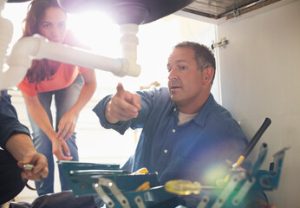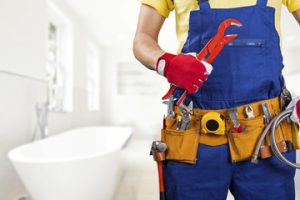Plumbing is the system of pipes, fixtures and fittings that carries water and sewage throughout a building. It involves installation, repair and maintenance. Plumbing also ensures that water is supplied safely and that waste is removed in a way that meets local codes and standards.

Our home plumbing systems are mysterious to many of us, running unseen behind walls and under floors, bringing freshwater in and taking wastewater away. But when problems arise, we turn to plumbers for help. Visit https://www.castlerockplumbingllc.com/ to learn more.
Water supply lines transfer fresh, clean drinking water to various fixtures in a home or business. These include showers, bathtubs, toilets, sinks, and appliances like dishwashers and clothes washers. Plumbing systems use the principles of gravity and pressure to convey water, ensuring that all outlets receive an adequate supply. They also take wastewater out to a drain system. A plumbing professional can help install, repair and maintain these systems.
Most of the public water supply in the United States is provided by government agencies that find, treat and transport freshwater to homes and businesses. They may also collect wastewater and transport it to sewage treatment plants. Private wells are another source of water, and some people draw their own supplies from these.
A plumbing system in a house starts with the main water line from the street. This line runs to the meter and water heater, which are connected by a valve. The meter registers the amount of water used, and the main shut-off valve is usually located near this meter to control access to the water supply. When a plumber needs to work on the pipes in a house, they can cut off the water by closing this valve.
The water supply pipes in a house are typically made from copper, PVC or other plastics. They can also be made from metals, but these are less common. Older homes often have pipes made from different materials. It is important for plumbers to understand the differences between these types of pipes so that they can make repairs quickly and accurately.
Despite their sturdy construction, plumbing pipes are subject to many factors that can affect how they function. For example, hard water can cause build-up on the inside of pipes, restricting flow and causing plumbing failures. High water pressure can also strain pipes and fittings, leading to leaks.
These issues can be difficult to diagnose and fix, but knowing the basics of how a plumbing system works can make them easier to understand. Regular maintenance can prevent problems from arising and keep the plumbing running smoothly.
Drainage
Drainage is essential to ensuring that buildings and their surrounding land stay safe and dry. It helps prevent structural damage, health issues and property loss by ensuring that water is directed away from the building. It also helps to keep rainwater and other natural moisture from building up and causing flooding and erosion.
A drainage system consists of pipes that remove waste water from plumbing fixtures and safely transport it to a sewer or septic tank. This includes drain lines that connect sinks, toilets and tubs to the main drain line, as well as vent pipes that allow air into the drain lines to maintain proper pressure and flow.
The pipes used in drainage systems are typically made of durable, corrosion-resistant materials such as polyvinyl chloride (PVC) or cast iron. They may be covered with a thin layer of concrete to protect them from groundwater contamination, or they may be buried underground. Underground pipes may be laid in a perforated pipe system called French drains, or in a series of trenches known as a trench drain system.
Drainage plumbing also includes a system of gutters and downspouts to collect and divert stormwater runoff. This keeps it from pooling around the foundation of a structure, which can lead to cracks and mold growth as well as unsafe conditions for people and pets.
Many different types of drain covers are available to help keep out debris such as leaves, pine needles and gunk. These can all gum up the works, making it difficult for water to flow properly. It’s important to regularly clean drains and downspouts to avoid blockages and keep water flowing smoothly.
When it comes to commercial plumbing, drainage is just as crucial as supply systems. From parking lot drains to roof drainage, a reliable drainage system is essential for maintaining a business’s operations and keeping customers happy. Commercial drainage systems are usually designed to handle large volumes of water and waste, so they must be able to withstand a high volume of traffic while remaining effective. When problems arise with a commercial drainage system, it can cause major disruptions to the business and result in costly repairs.
Fixtures
A plumbing fixture is a device used to supply water or remove waste, providing essential sanitary functions in residential and commercial settings. Common fixtures include sinks, toilets, bathtubs, shower receptors, and faucets. A plumbing fixture can be made from a wide variety of materials, including glass, porcelain, bronze, copper, and stainless steel. Some are designed for aesthetic appeal while others offer improved functionality.
For example, a bathtub may be shaped to maximize space or built with high-quality enamel to provide a smooth finish that resists scratches and chipping. A showerhead, on the other hand, can be designed to deliver a particular flow pattern or feature to provide optimal comfort for users. Some plumbing fixtures are also more energy efficient than others, which can reduce water usage and utility bills in a home or business.
Plumbing fixtures are also available in a range of styles, from minimalist and contemporary to ornately decorative. They can help establish an overall design theme for bathrooms and kitchens, and they can complement a wide range of décor. It’s important to choose fixtures that are durable, easy to maintain, and in keeping with the style of a room.
It’s also essential to know how long a plumbing fixture is expected to last so that homeowners can plan for replacements and budget accordingly. Lifespan varies depending on the quality of the material, installation method, and frequency of use. By knowing how much to expect from a fixture’s lifespan, homeowners can make informed decisions about repairs and replacements, avoiding expensive surprises down the road.
A professional plumber can assist in determining which fixtures are right for a particular environment, installing them correctly, and performing regular maintenance to prevent damage and improve performance. They can also educate clients on how to minimize unnecessary water usage and costs by using energy-efficient products.
As more and more people turn to sustainable, eco-friendly living, the demand for greener plumbing fixtures is on the rise. Manufacturers have responded by offering a wide array of options that can significantly cut down on utility bills without sacrificing functionality or appearance.
Installation
When installing plumbing fixtures and pipes, there are several steps a plumber must take to ensure compliance with local codes and standards. These include preparing the installation area, turning off the water supply, and using appropriate tools and materials for the job. In some cases, a permit may be required to ensure that all work meets quality and safety standards. A plumber must also test and inspect the finished plumbing system to ensure that it works properly.
While there are some jobs a homeowner can do themselves, such as replacing a showerhead or faucet, most require the services of a licensed professional. Plumbers are skilled craftsmen who can install and repair complex plumbing systems, ensuring that the building’s occupants have a safe and reliable source of water and proper waste removal. They can also help with home energy efficiency by advising on the use of water-saving fixtures and pipes.
A plumber must be able to read blueprints and understand the technical aspects of building design and construction. They must also be able to work with a variety of tools and materials, including pipe cutters, wrenches, drills, sealants, stud finders, and more. Plumbers often work with other tradespeople, such as electricians and carpenters, to complete construction projects. They must be able to communicate effectively and work safely in tight spaces.
Many plumbing tasks are time-consuming and labor-intensive, such as removing old fixtures and pipes, running new pipe, and cleaning up the installation area. However, by taking the time to prepare and plan ahead, a plumbing project can be completed quickly and efficiently. Before starting a project, it’s important to have all necessary tools and materials nearby to prevent delays and frustration. It’s also essential to wear protective gear and follow proper safety procedures when working with hazardous materials.
By choosing energy-efficient fixtures and pipes, you can save money on your utility bills while improving the comfort and functionality of your home. In addition to reducing your monthly water bill, using water-saving appliances can help reduce your carbon footprint and protect the environment. To get started, look for high-efficiency toilets, showerheads, and faucets at your local hardware or home improvement store.
